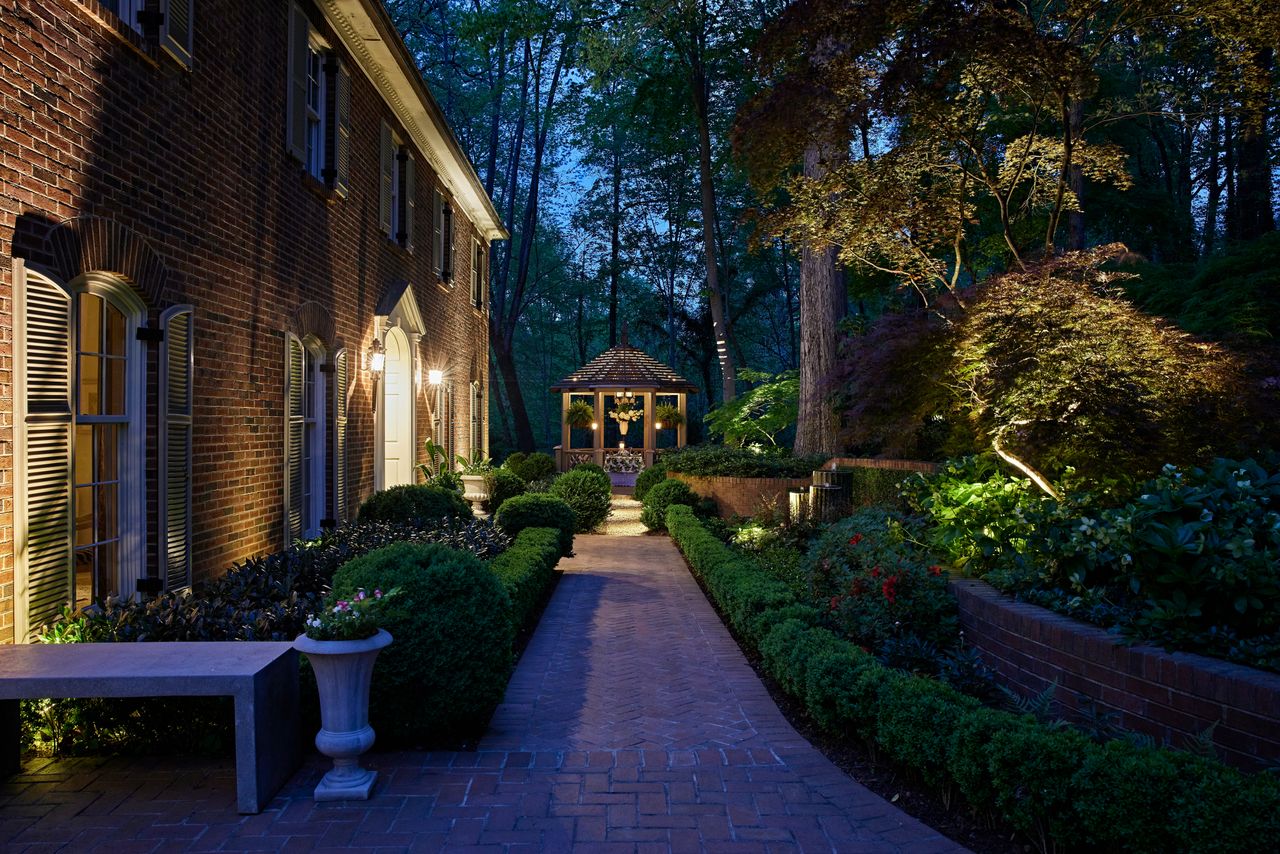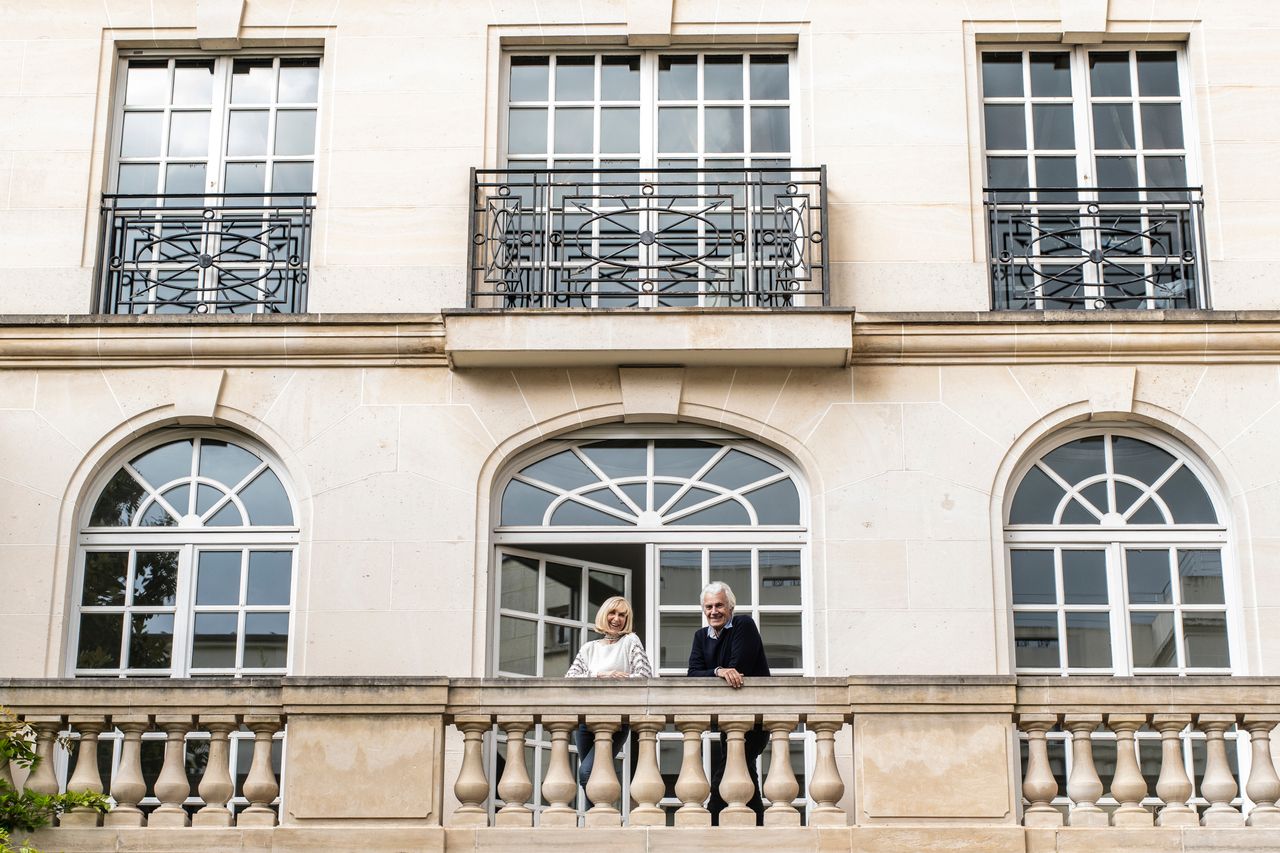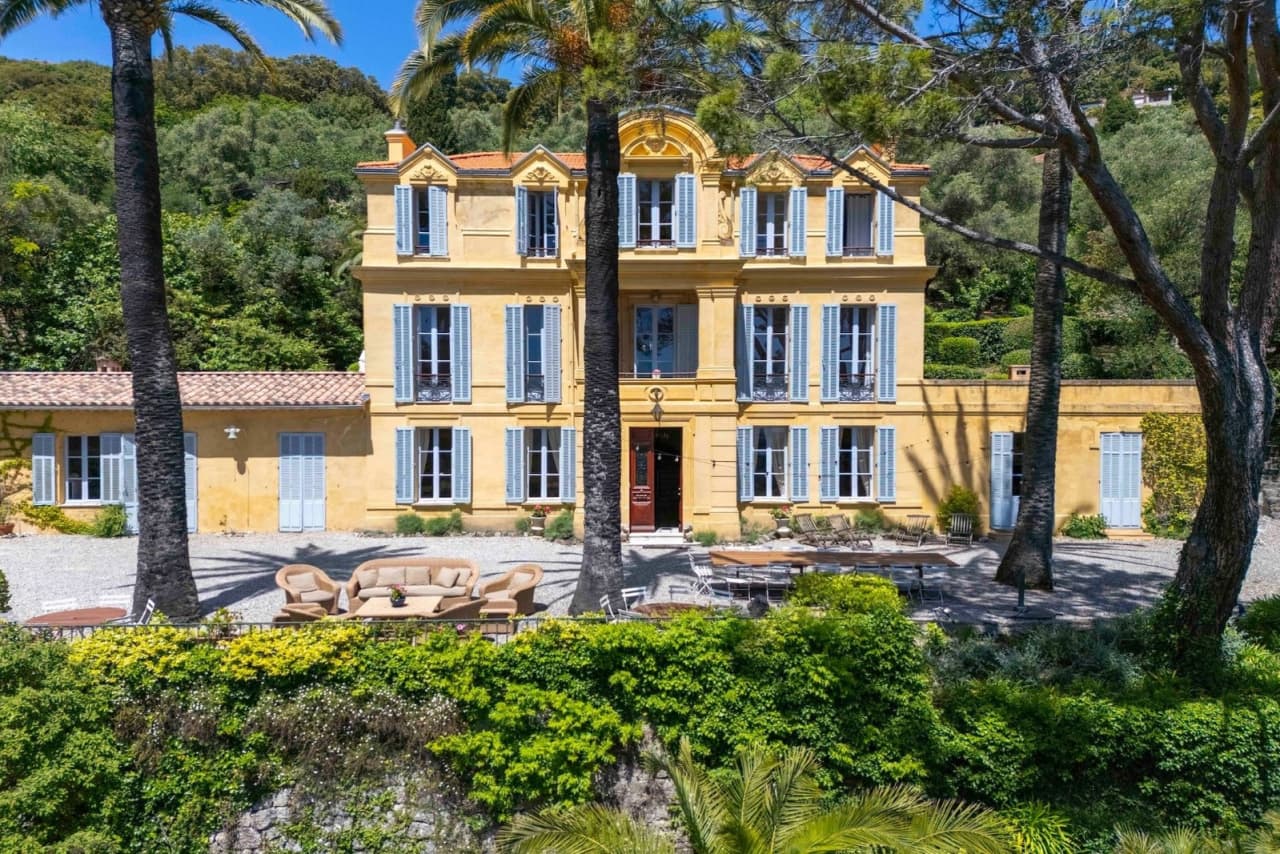Outdoor Lighting Ideas To Turn Your Yard Into A Luxury Resort
The best way to make your outdoor space elegantly enjoyable after dark.
Last summer, those of us charmed enough to have a backyard to call our own tended our gardens and zhushed our patios with new furniture, maybe even springing for an outdoor rug. When it came to exterior lighting, however, most people aimed no higher than a swag of Edison-bulb string lights and a feebly flickering hurricane candle.
“Outdoor spaces sometimes get overlooked after the sun goes down,” said Memphis interior designer Sean Anderson, alluding to such lame attempts at illumination. This spring, however, as we prepare to host en plein air again, why not tackle outdoor lighting—especially if you’ve upgraded everything else? Beyond a wish to enjoy their private plot at night, homeowners light landscapes “so that when you’re inside the house you can see the garden and not just a black hole,” said Ive Haugeland, founding principal of Shades of Green, a landscape architecture firm in Sausalito, Calif.
The best way to banish murky shadows is to borrow the sort of layered lighting scheme found in professionally designed living rooms. In simplest terms, you want three tiers. Start with the highest level, via lofty lanterns or up-lighting that draws eyes skyward or even chandeliers (yes, weatherproof versions exist; see “Worth Wiring”). Next fill in the midrange with sconces, illuminated plants or sculptures and tabletop portable lanterns. And don’t forget low-level illumination—that is path, understep and underseat lighting.
The cumulative effect should be subtle, not stark, “that feeling of fireflies on a summer night, that sense of discovery,” as San Francisco designer Ken Fulk put it. “The default has previously been an overly lit space.”
At a residence in San Francisco, Ms. Haugeland recently hung two outdoor-rated glass chandeliers beneath a minimalist pergola. To provide eye-level glow, she uplit the knotty trunks of century-old olive trees, then set low LED lighting into step risers for safer sauntering after dark. The chandeliers are “a little over the top, so they’re very fun and playful and what you don’t expect to see outside,” said Ms. Haugeland.
Solar-powered outdoor fixtures are still too dim to rely on, said the landscape architects we polled. A reasonably sized fixture can’t house enough photovoltaic cells to produce anything but a sickly glow. Meanwhile, the latest low-voltage LEDs not only last a long time, they can be easily and cheaply wired. “[In the] 1980s and into the ’90s, landscape lighting was run using high-voltage electricity,” said Washington, D.C., landscape architect Joseph Richardson, who recently uplit the river birch trees surrounding his own Arlington, Va., home. “It meant fixtures were very large and very bulky, and the cost was extreme. You had to run buried conduit plastic pipes through the yard, and if someone were to hit that with a shovel they could be electrocuted.”
Today’s LED fixtures suck as little as 3 watts as opposed to the 35 watts that incandescents fed on, Mr. Richardson said. That means “you can use low-voltage wiring—a small wire that lays on top of soil under mulch,” said Megumi Aihara, founding partner and principal of San Francisco’s Spiegel Aihara Workshop. “You can install [that] after a garden is built, and it would not hurt you if you touched those wires.” (Note: The designers we interviewed recommended hiring a professional electrician or landscape firm to at least install your main transformer, which converts your home’s 120-volt juice to 12-volt power.)
To light her North Carolina yard (pictured on D1) designer Gray Walker turned to low-voltage specialists Outdoor Lighting Perspectives (OLP) of Charlotte. A brick walkway behind her house leads to a small eight-sided gazebo. “You’ve got your path lights to illuminate the ground and then I like to lift the eye up,” said Ms. Walker. Uplit oak trees and Japanese magnolias create a “wonderland” of branches. The path passes a trio of gurgling columnar fountains that are highlighted to provide midlevel illumination, while other lights shine on shrubs, casting shadows on the brick exterior of her Georgian-style home. “This adds a bit of texture and dimension to the wall,” said Mari Zaragoza, production coordinator at OLP. “It was important to not keep everything in the same level, to create as much depth and texture as possible.”
Ms. Walker’s gazebo quietly commands attention at night. Two upturned accent lights shine thin lines of light through its slatted roof for a “glowing effect,” said Ms. Zaragoza. “We really thought this created a natural focal point without it being too overdone.”
Low-voltage lighting helped Ms. Aihara execute a multilevel scheme in a Los Angeles yard (pictured, above). Perforated metal tubes diffuse light throughout the canopy of deciduous trees, and cast modest pools on the deck and the greenery that surrounds it. Another one of Ms. Aihara’s tricks: Dek Dots from Dekor lighting. “They’re small, half-inch LED dots,” she said. “During the day, they disappear, and at night they twinkle on the ground.”
Don’t wish to deal with running any kind of electrical wiring? You can easily find options that plug into an outdoor socket but are far more aesthetically ambitious than string lights. Examples include articulating floor lamps and hanging lamps like Lightology’s Garota Plug-In Pendant (see “No-Pro Lamps”).
Even better: lights that you can cart around as freely as a flashlight. “We’re noticing an increased interest in rechargeable, free-standing lights that run on LED bulbs and batteries,” said Greenwich, Conn., landscape architect Janice Parker. Check out the cartoonish mushroom lamps from Hay at the MoMA Design Store as well as braided-rope lanterns by Talenti. Both double as tabletop and path lighting. Ms. Parker hangs portable LED lanterns from tree branches or decorative hangers. “You can easily move them around as needed, and guests can use them if they want to go for a stroll.”
Other landscape architects are eschewing visible fixtures altogether, hiding strips of LEDs under stair treads, for example. In the courtyard of a Berkeley, Calif., home, design firm Delaney + Chin tucked wet-location LED tape under a white stone bench as well as in the ground to shine a wash of light along the bottom of a corten steel wall. The goal, as Ms. Parker put it, is to achieve lighting “that you do not perceive as coming from fixtures but naturally from the moon.” Roderick Wyllie of Surfacedesign, a landscape architecture firm in San Francisco, recommends placing fixtures at least a foot away from the plant or architectural element they’re meant to highlight to avoid harsh, unflattering “hot spots.”
Such toned-down design lets us see and appreciate the nighttime sky, notes Mr. Wyllie. Many municipalities are embracing dark-skies policies intended to curb light pollution and lessen the impact on birds, the bugs they eat and other fauna, said Matthew Bromley, a landscape designer in Bedford, N.Y. “We can be impactful without being garish or feeling like we’re in Las Vegas.”
You may not need as many path lights as you think, for example. Mr. Richardson said one of the habitual mistakes homeowners make when they tackle lighting themselves is spacing path lights too closely. “It almost gives you a runway effect,” he said, adding that you can ensure navigability without committing overkill. “I try not to space [them] any closer than maybe 12 feet apart.”
Another interior technology that has moved outdoors: dimming. “There are times when you may want outdoor lights brighter or dimmer for whatever reason,” said Mr. Fulk. Perhaps you wish to bring the lights up slowly as the sun retires. He reports a growing demand for this flexibility. Similarly, multiple designers said their clients love that many LEDs can be tweaked—even transformed into a rainbow of hues—from their smartphones using programs from Lutron Homeworks and Savant.
As with LEDs inside your home, colour temperature, or Kelvin ratings, matter. A bulb on the high end of the Kelvin range, near 6500, will emit a cooler, bluer light. Lower kelvins translate to warmer, softer whites. For outdoor use, Dan Spiegel, who’s also a founding partner and principal at Spiegel Aihara Workshop, advises selecting lightbulbs with lower colour temperatures, around 2700 Kelvins.
Whether you hire professionals or do it yourself, Mr. Richardson recommends starting slowly. You can add extra light sources later. “Once you take the fixture out of the packaging and stick it in the ground it gets harder to return.” For her part, every time Ms. Walker pulls into her driveway at night, she appreciates the effort she’s put into her lighting, she said, from the gazebo to the glow-guided path. “It just makes me feel like I live in a little jewel box.”
NO-PRO LAMPS
Six rechargeable or plug-in lights you can layer into a three-tiered scheme yourself
Low
From left: Hay PC Portable Lamp, approx. $122, store.moma.org; Talenti Tribal Lamp, approx. $1544, Cantoni, 972-934-9191
Medium
From left: Inda Copenhagen Table Lamp, approx. $1100, Burke Decor 888-338-8111; Pedrali Giravolta Floor Lamp, approx. $510, shopdecor.com
High
From left: Simple String Lights, approx. $577, westelm.com; Garota Plug-In Pendant, approx. $1300, lightology.com
Reprinted by permission of The Wall Street Journal, Copyright 2021 Dow Jones & Company. Inc. All Rights Reserved Worldwide. Original date of publication: April 23, 2021.
 Copyright 2020, Dow Jones & Company, Inc. All Rights Reserved Worldwide. LEARN MORE
Copyright 2020, Dow Jones & Company, Inc. All Rights Reserved Worldwide. LEARN MORE
This stylish family home combines a classic palette and finishes with a flexible floorplan
Just 55 minutes from Sydney, make this your creative getaway located in the majestic Hawkesbury region.
Ahead of the Games, a breakdown of the city’s most desirable places to live
PARIS —Paris has long been a byword for luxurious living. The traditional components of the upscale home, from parquet floors to elaborate moldings, have their origins here. Yet settling down in just the right address in this low-rise, high-density city may be the greatest luxury of all.
Tradition reigns supreme in Paris real estate, where certain conditions seem set in stone—the western half of the city, on either side of the Seine, has long been more expensive than the east. But in the fashion world’s capital, parts of the housing market are also subject to shifting fads. In the trendy, hilly northeast, a roving cool factor can send prices in this year’s hip neighborhood rising, while last year’s might seem like a sudden bargain.
This week, with the opening of the Olympic Games and the eyes of the world turned toward Paris, The Wall Street Journal looks at the most expensive and desirable areas in the City of Light.
The Most Expensive Arrondissement: the 6th
Known for historic architecture, elegant apartment houses and bohemian street cred, the 6th Arrondissement is Paris’s answer to Manhattan’s West Village. Like its New York counterpart, the 6th’s starving-artist days are long behind it. But the charm that first wooed notable residents like Gertrude Stein and Jean-Paul Sartre is still largely intact, attracting high-minded tourists and deep-pocketed homeowners who can afford its once-edgy, now serene atmosphere.
Le Breton George V Notaires, a Paris notary with an international clientele, says the 6th consistently holds the title of most expensive arrondissement among Paris’s 20 administrative districts, and 2023 was no exception. Last year, average home prices reached $1,428 a square foot—almost 30% higher than the Paris average of $1,100 a square foot.
According to Meilleurs Agents, the Paris real estate appraisal company, the 6th is also home to three of the city’s five most expensive streets. Rue de Furstemberg, a secluded loop between Boulevard Saint-Germain and the Seine, comes in on top, with average prices of $2,454 a square foot as of March 2024.
For more than two decades, Kyle Branum, a 51-year-old attorney, and Kimberly Branum, a 60-year-old retired CEO, have been regular visitors to Paris, opting for apartment rentals and ultimately an ownership interest in an apartment in the city’s 7th Arrondissement, a sedate Left Bank district known for its discreet atmosphere and plutocratic residents.
“The 7th was the only place we stayed,” says Kimberly, “but we spent most of our time in the 6th.”
In 2022, inspired by the strength of the dollar, the Branums decided to fulfil a longstanding dream of buying in Paris. Working with Paris Property Group, they opted for a 1,465-square-foot, three-bedroom in a building dating to the 17th century on a side street in the 6th Arrondissement. They paid $2.7 million for the unit and then spent just over $1 million on the renovation, working with Franco-American visual artist Monte Laster, who also does interiors.
The couple, who live in Santa Barbara, Calif., plan to spend about three months a year in Paris, hosting children and grandchildren, and cooking after forays to local food markets. Their new kitchen, which includes a French stove from luxury appliance brand Lacanche, is Kimberly’s favourite room, she says.
Another American, investor Ashley Maddox, 49, is also considering relocating.
In 2012, the longtime Paris resident bought a dingy, overstuffed 1,765-square-foot apartment in the 6th and started from scratch. She paid $2.5 million and undertook a gut renovation and building improvements for about $800,000. A centrepiece of the home now is the one-time salon, which was turned into an open-plan kitchen and dining area where Maddox and her three children tend to hang out, American-style. Just outside her door are some of the city’s best-known bakeries and cheesemongers, and she is a short walk from the Jardin du Luxembourg, the Left Bank’s premier green space.
“A lot of the majesty of the city is accessible from here,” she says. “It’s so central, it’s bananas.” Now that two of her children are going away to school, she has listed the four-bedroom apartment with Varenne for $5 million.
The Most Expensive Neighbourhoods: Notre-Dame and Invalides
Garrow Kedigian is moving up in the world of Parisian real estate by heading south of the Seine.
During the pandemic, the Canada-born, New York-based interior designer reassessed his life, he says, and decided “I’m not going to wait any longer to have a pied-à-terre in Paris.”
He originally selected a 1,130-square-foot one-bedroom in the trendy 9th Arrondissement, an up-and-coming Right Bank district just below Montmartre. But he soon realised it was too small for his extended stays, not to mention hosting guests from out of town.
After paying about $1.6 million in 2022 and then investing about $55,000 in new decor, he put the unit up for sale in early 2024 and went house-shopping a second time. He ended up in the Invalides quarter of the 7th Arrondissement in the shadow of one Paris’s signature monuments, the golden-domed Hôtel des Invalides, which dates to the 17th century and is fronted by a grand esplanade.
His new neighbourhood vies for Paris’s most expensive with the Notre-Dame quarter in the 4th Arrondissement, centred on a few islands in the Seine behind its namesake cathedral. According to Le Breton, home prices in the Notre-Dame neighbourhood were $1,818 a square foot in 2023, followed by $1,568 a square foot in Invalides.
After breaking even on his Right Bank one-bedroom, Kedigian paid $2.4 million for his new 1,450-square-foot two-bedroom in a late 19th-century building. It has southern exposures, rounded living-room windows and “gorgeous floors,” he says. Kedigian, who bought the new flat through Junot Fine Properties/Knight Frank, plans to spend up to $435,000 on a renovation that will involve restoring the original 12-foot ceiling height in many of the rooms, as well as rescuing the ceilings’ elaborate stucco detailing. He expects to finish in 2025.
Over in the Notre-Dame neighbourhood, Belles demeures de France/Christie’s recently sold a 2,370-square-foot, four-bedroom home for close to the asking price of about $8.6 million, or about $3,630 a square foot. Listing agent Marie-Hélène Lundgreen says this places the unit near the very top of Paris luxury real estate, where prime homes typically sell between $2,530 and $4,040 a square foot.
The Most Expensive Suburb: Neuilly-sur-Seine
The Boulevard Périphérique, the 22-mile ring road that surrounds Paris and its 20 arrondissements, was once a line in the sand for Parisians, who regarded the French capital’s numerous suburbs as something to drive through on their way to and from vacation. The past few decades have seen waves of gentrification beyond the city’s borders, upgrading humble or industrial districts to the north and east into prime residential areas. And it has turned Neuilly-sur-Seine, just northwest of the city, into a luxury compound of first resort.
In 2023, Neuilly’s average home price of $1,092 a square foot made the leafy, stately community Paris’s most expensive suburb.
Longtime residents, Alain and Michèle Bigio, decided this year is the right time to list their 7,730-square-foot, four-bedroom townhouse on a gated Neuilly street.
The couple, now in their mid 70s, completed the home in 1990, two years after they purchased a small parcel of garden from the owners next door for an undisclosed amount. Having relocated from a white-marble château outside Paris, the couple echoed their previous home by using white- and cream-coloured stone in the new four-story build. The Bigios, who will relocate just back over the border in the 16th Arrondissement, have listed the property with Emile Garcin Propriétés for $14.7 million.
The couple raised two adult children here and undertook upgrades in their empty-nester years—most recently, an indoor pool in the basement and a new elevator.
The cool, pale interiors give way to dark and sardonic images in the former staff’s quarters in the basement where Alain works on his hobby—surreal and satirical paintings, whose risqué content means that his wife prefers they stay downstairs. “I’m not a painter,” he says. “But I paint.”
The Trendiest Arrondissement: the 9th
French interior designer Julie Hamon is theatre royalty. Her grandfather was playwright Jean Anouilh, a giant of 20th-century French literature, and her sister is actress Gwendoline Hamon. The 52-year-old, who divides her time between Paris and the U.K., still remembers when the city’s 9th Arrondissement, where she and her husband bought their 1,885-square-foot duplex in 2017, was a place to have fun rather than put down roots. Now, the 9th is the place to do both.
The 9th, a largely 19th-century district, is Paris at its most urban. But what it lacks in parks and other green spaces, it makes up with nightlife and a bustling street life. Among Paris’s gentrifying districts, which have been transformed since 2000 from near-slums to the brink of luxury, the 9th has emerged as the clear winner. According to Le Breton, average 2023 home prices here were $1,062 a square foot, while its nearest competitors for the cool crown, the 10th and the 11th, have yet to break $1,011 a square foot.
A co-principal in the Bobo Design Studio, Hamon—whose gut renovation includes a dramatic skylight, a home cinema and air conditioning—still seems surprised at how far her arrondissement has come. “The 9th used to be well known for all the theatres, nightclubs and strip clubs,” she says. “But it was never a place where you wanted to live—now it’s the place to be.”
With their youngest child about to go to college, she and her husband, 52-year-old entrepreneur Guillaume Clignet, decided to list their Paris home for $3.45 million and live in London full-time. Propriétés Parisiennes/Sotheby’s is handling the listing, which has just gone into contract after about six months on the market.
The 9th’s music venues were a draw for 44-year-old American musician and piano dealer, Ronen Segev, who divides his time between Miami and a 1,725-square-foot, two-bedroom in the lower reaches of the arrondissement. Aided by Paris Property Group, Segev purchased the apartment at auction during the pandemic, sight unseen, for $1.69 million. He spent $270,000 on a renovation, knocking down a wall to make a larger salon suitable for home concerts.
During the Olympics, Segev is renting out the space for about $22,850 a week to attendees of the Games. Otherwise, he prefers longer-term sublets to visiting musicians for $32,700 a month.
Most Exclusive Address: Avenue Junot
Hidden in the hilly expanses of the 18th Arrondissement lies a legendary street that, for those in the know, is the city’s most exclusive address. Avenue Junot, a bucolic tree-lined lane, is a fairy-tale version of the city, separate from the gritty bustle that surrounds it.
Homes here rarely come up for sale, and, when they do, they tend to be off-market, or sold before they can be listed. Martine Kuperfis—whose Paris-based Junot Group real-estate company is named for the street—says the most expensive units here are penthouses with views over the whole of the city.
In 2021, her agency sold a 3,230-square-foot triplex apartment, with a 1,400-square-foot terrace, for $8.5 million. At about $2,630 a square foot, that is three times the current average price in the whole of the 18th.
Among its current Junot listings is a 1930s 1,220-square-foot townhouse on the avenue’s cobblestone extension, with an asking price of $2.8 million.
This stylish family home combines a classic palette and finishes with a flexible floorplan
Just 55 minutes from Sydney, make this your creative getaway located in the majestic Hawkesbury region.






















